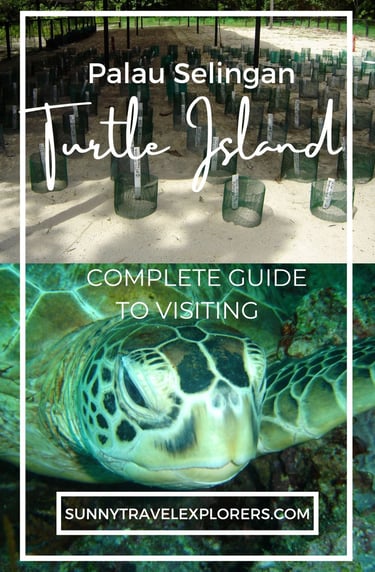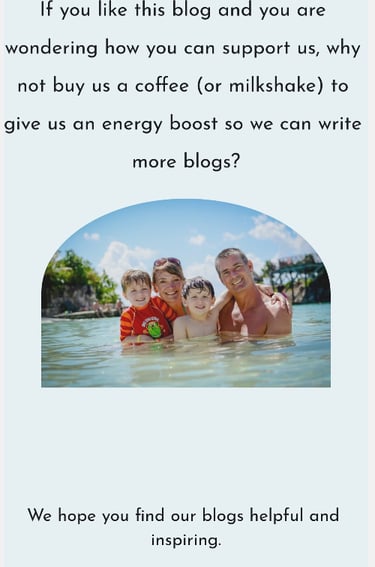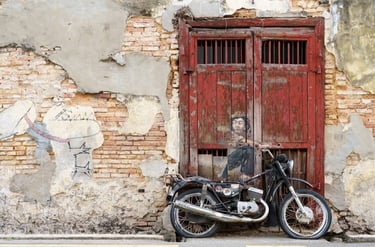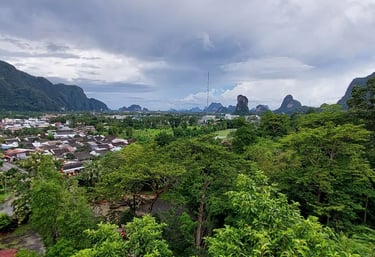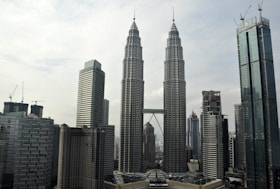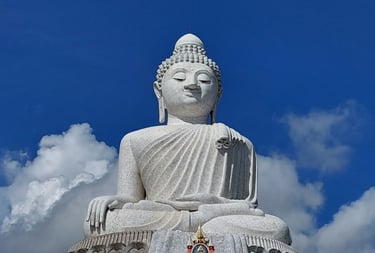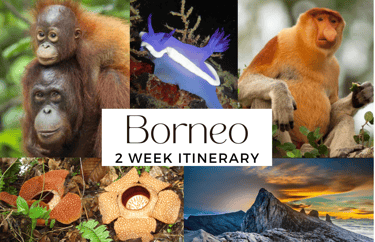
Complete Guide To Visiting Turtle Island - Palau Selingan Borneo
Palau Selingan Borneo is renowned as a nesting ground for endangered Turtles, offering visitors a unique and unforgettable experience witnessing these beautiful creatures nesting and tiny hatchlings being released in a conservation-focused environment.
MALAYSIA
It’s the perfect environment for kids to witness one of nature’s greatest phenomenons, and it’s one of the few places in the world where turtles arrive 365 days of the year to nest!
If you’re planning a trip to Borneo, visiting Turtle Island (Pulau Selingan) off the Eastern coast will be one of the highlights of your trip.
Part of the Sabah National Park, Turtle Island is one of three islands dedicated to Green and Hawksbill Turtle conservation, and the only island which permits visitors to view turtles nesting and hatchlings being released.
Having dived all around the World we have seen plenty of turtles underwater, but we wouldn't wait to get to Palau Selingan to witness the fantastic conservation program as well as witness turtles nesting and the tiny hatchlings being released.
Three tiny islands in the Sulu Sea off the east coast of Borneo make up Turtle Island National Park. You’ll find Turtle Island or in Malaysian, Palau Selingan 40km north from Sabah’s second city, Sandakan.
The islands of Selingan, Bakungan Kecil and Gulisan plus the surrounding turquoise waters and reef, make up 1,740 hectares of the protected area, dedicated to Turtle Conservation since 1977. All three islands have turtle hatcheries but Palau Selingan (Turtle Island) is the only island to permit visitors to view the turtles nesting and hatchlings being released.
The beaches of these three islands are visited every night of the year by two endangered turtle species, the Green Turtle and the Hawksbill Turtle. You are pretty much guaranteed to see turtles nesting!
Where Is Turtle Island In Borneo?
Booking Turtle Island Borneo
Visitors can only visit as part of a 2D1N tour (returning back early morning at 7.00am on the second day) with local company, Crystal Quest. Visitor numbers are limited to 50 per night so pre-booking is essential. It is not possible to visit on a day trip.
All tickets are sold through Crystal Quest, a company with an office on the jetty next to the Sabah Parks office. Other tour operators may also sell tickets and include a guide with the fee.
The Sabah Parks and Crystal Quest offices are right on a jetty 10 minutes walk (2 minute taxi ride) from central Sandakan. If you haven’t booked before your arrival at Sandakan airport, get your taxi driver to stop off at the office on the way into Sandakan – you’ll drive straight past it.
There’s also an additional National Park entry fee payable on arrival and a camera fee per camera/device/mobile phone.
Best Time To Visit Palau Selingan (Turtle Island)
The best time to visit the turtles on Palau Selingan is when the sea conditions are calmer, which is typically July to October (also coinciding with the peak season in the rest of Borneo). Although this is no guarantee of good weather!
The Transfer To Palau Selingan
The boats leave at 9.30am from the jetty next to the Crystal Quest office.
Before we knew it, we were crossing the Sulu Sea at great speed and arrived on a tiny sand fringed paradise island an hour later.
The island is so small it doesn’t take very long to walk around. One side of the island has a beautiful sandy beach whilst the other side is rocky reef.
Palau Selingan Chalet Accommodation
Accommodation is in four large chalet buildings located some 500m from the main building housing the Education Centre, shop and restaurant.
The accommodation is simple and basic, but most importantly clean with air conditioning.
We had no complaints at all about the accommodation. It is tired, but the air conditioning worked, the rooms were spotless and the beds perfectly comfy. After all we were there for the turtles and not a 5 star luxury experience. We hardly spent any time in the rooms at all.
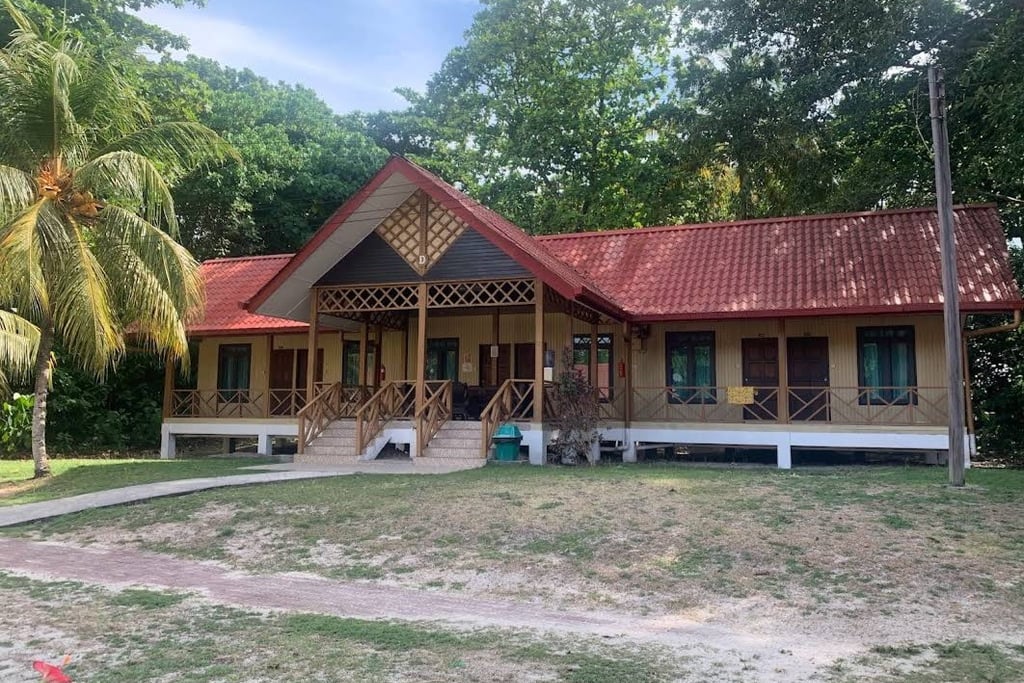

Do you want to read this later? Save this PIN on your Malaysia Board on Pinterest and read it later
What To Do At Palau Selingan?
After settling into our accommodation, the day was ours to relax, swim and snorkel. The beach is lifeguarded with a designated area for snorkelling. The water is crystal clear and the snorkelling excellent! The array of marine life was truly remarkable. Make sure you bring your snorkel and mask.
You might spot hungry monitor lizards stalking the sand for turtle eggs. The Rangers retrieve the buried turtle eggs from almost all nests on the island and re-house them in the hatchery to deter predators however, they do leave some nests wild to ensure that other species, dependant on turtle eggs as part of their diet, can still survive.
After snorkelling, we walked around the island, not an easy task due to the furthest side of the island being covered in sharp rocks, we recommend sturdy footwear or water shoes. Unfortunately, we did come across a large amount of litter and debris washed up. This was sad to see as this is a protected park and the discarded items are dangerous to turtles.
The Education Centre housed exhibits which are extremely informative and provide a lot of background and interesting facts.
An interesting fact is that temperature of the sand the eggs are incubated in plays a vital role in determining the sex of the turtle. Higher temperatures result in more females. Conversely males dominate in lower temperatures. Some hatcheries are shaded to ensure certain nests are cooler than others. A small change in temperature can mean a nest is wholly female or male. This curious fact underlines the importance of hatchery management.

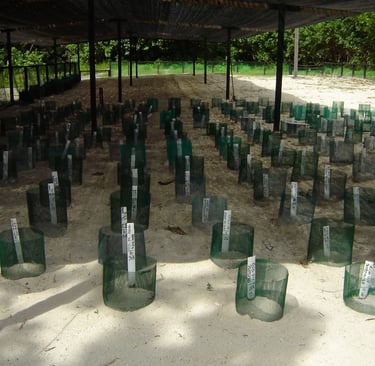

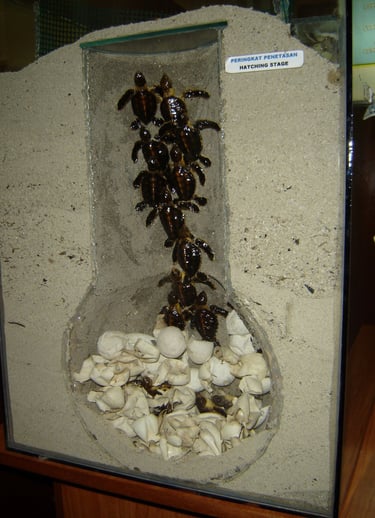


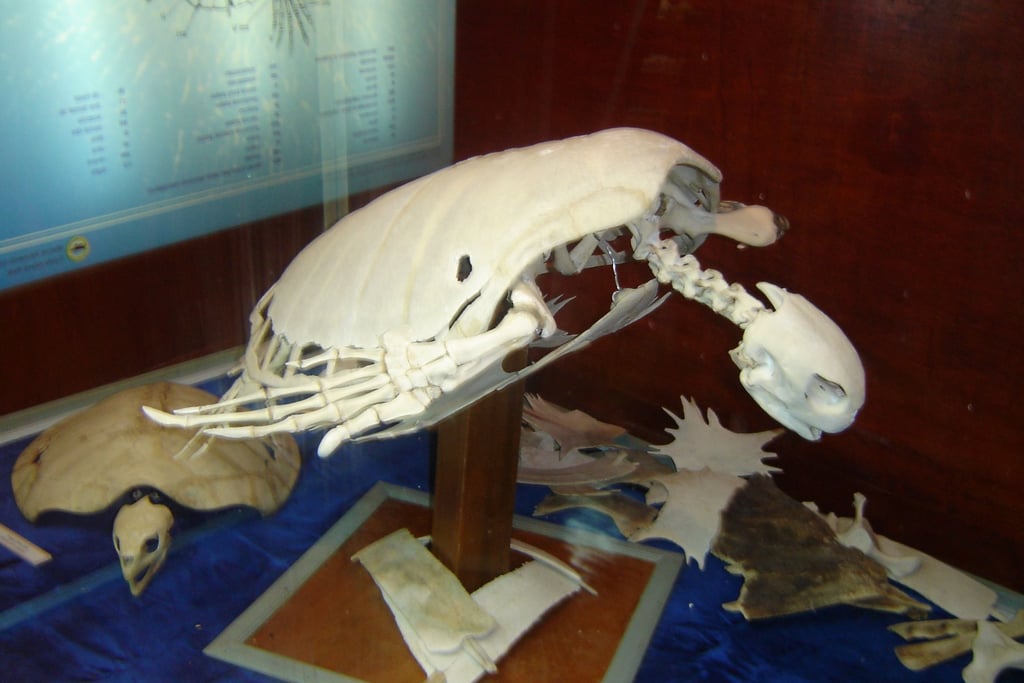

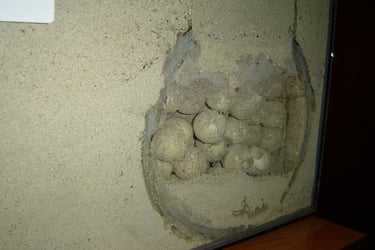

We stayed on the beaches until sunset, when the park rules and regulations are strictly enforced and visitors are not allowed on the beach from sunset to sunrise so as not to disturb the turtles.
After sunset, we enjoyed a buffet dinner and sat with the other visitors expectantly waiting for ‘Turtle Time’.
A video is shown above the restaurant in the Education Centre describing the lives of Green and Hawksbill Turtles from breeding, hatching and what little is known of their life at sea.
Turtle Time
A team of five full time Rangers are on patrol every evening and work tirelessly as each female nests, to carefully remove her eggs and re-locate them to a new nest dug in the safer confines of the island’s hatchery.
As with all our other turtle nesting experiences, you have no idea how long you might have to wait until a Ranger calls you to the beach.
Finally we got the call and excitedly we followed the Ranger to the beach.
We all gathered around as the Ranger talked in hushed tones to us.
Turtle nesting is a phenomenon that occurs mainly at night.
Being reptiles, turtles cannot regulate their body temperature. Coming on shore during the day exposes them to extreme heat. Their huge, dark coloured shells collect solar energy, which can prove fatal.
Nesting turtles are sensitive to light. A bright light on or near their nesting beach is a major deterrent and they may avoid coming onshore entirely or they return to sea without laying their eggs.
The rules were to use only our red lights on our head torches and no flash photography.
Dragging herself beyond the high-water mark, the female digs a deep chamber shaped like a flask. During egg laying she seems to be a trance, oblivious to movement or sound. The chamber slowly fills with soft, glistening eggs each with its own minute pulsing embryo. Sea Turtles have enormous salt water glands behind their eyes. These allow them to expel salt taken in at sea. The salty mucus gives the impression of tears during egg laying.
We watched awestruck as the Ranger measured the female turtle. She was already tagged, meaning that she’d been to this beach before and the park would have information on her from her tracking device. Rangers tag first-time visitors to the island. We watched as she laboriously dug her nest and proceeded to plop out 136 glistening white eggs, the size of ping pong balls.
The Ranger carefully collects all of the eggs and visitors are lead away from the beach immediately so as not to disturb other nesting turtles, which are sensitive to movement. Carefully we negotiated our way back to the hatchery and to our surprise, passed a number of nesting turtles on our return.
We then watched the Ranger transplant the freshly laid eggs into a man-made nest dug 60-75cm deep which is similar in size and shape to the natural nest. These nests are protected from natural predators.
The eggs are placed in a pit 30 inches deep. A plastic wire mesh cylinder keeps out unwanted predators. An information plate contains a serial number, the date of collection, and number of eggs transplanted.
To make way for new nests, old ones must be removed, irregularities noted and records updated. Beaches and nesting areas should be safe and clean to ensure easy passage.

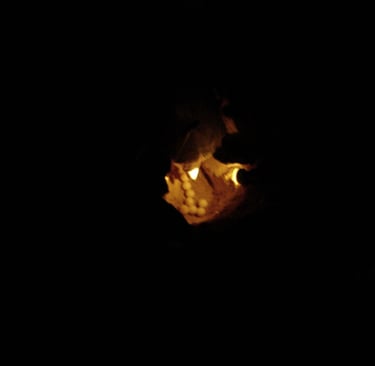
Not a great photograph due to no flash photography but you get the idea!
Hatchling Release
The final stage of the evening is the release of hatchlings – baby turtles!
Baby turtles take between 50-60 days from being laid to hatch. Baby turtles hatch usually after sundown, on sensing the coolness of night. At the hatcheries they are released immediately.
We were able to witness the baby turtles being released from their basket and watching as instinct kicked in and they were drawn to the pounding ocean. It was uplifting watching these tiny creatures bob up and down in the waves before disappearing into the depths.
Being the most vulnerable when young, only a few will survive.
Survival strategy calls for numerous offspring to emerge at the same time as swarming predators who are unable to consume them all. In nature the survival of the population species takes precedence over individuals. The few hatchlings that survive the initial frenzy probably seek refuge in rafts of tangled seaweed floating in sea currents.
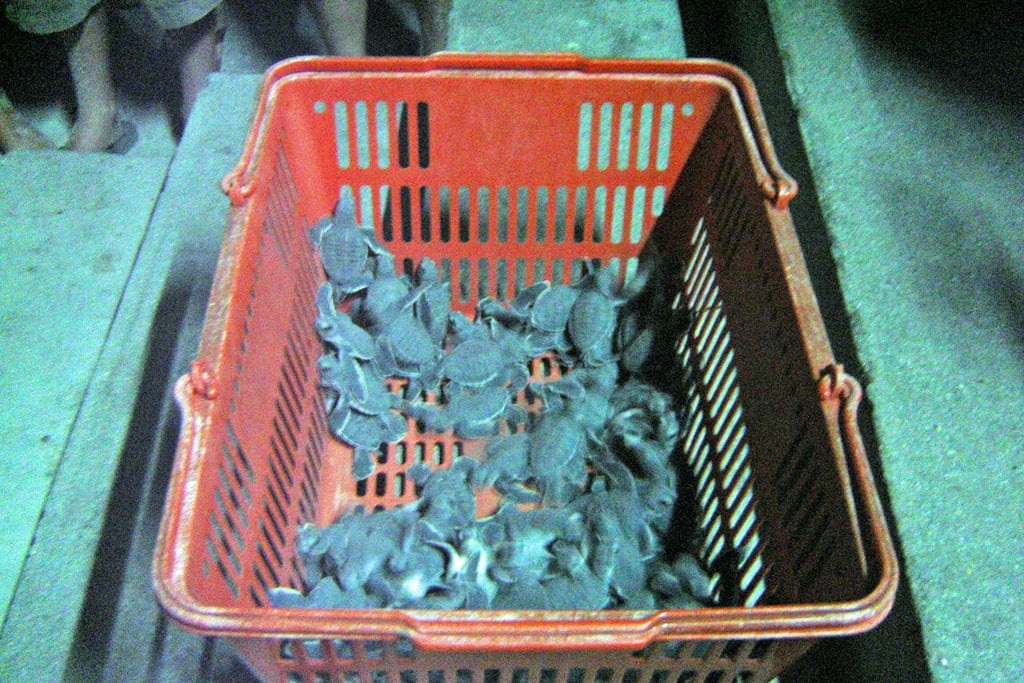

Again, not a great photograph due to no flash photography but you get the idea!
Marine Turtles
Marine turtles have lived on earth for about 185 million years. Fossil records show that more than 30 species of marine turtle have been known to have gone extinct naturally.
Today only 7 species of sea turtle still exist made up of two families – Dermochelyidae and Cheloniidae. Only the Leatherback is Dermochelyidae whilst the remaining six – Green, Hawksbill, Loggerhead, Flatback and Olive Ridley and Kemps Ridley are Cheloniidae.
Having survived millions of years, the sea turtle must now face it’s biggest challenge. Its habitats have never been more threatened. Its surroundings never more hostile.
Many perish from simply swallowing discarded items. Plastic bags, often mistaken for jellyfish, are lethal. When swallowed they block up the intestines, killing the turtle.
To the turtle being caught in a fishing net means certain death. Although adapted to a life underwater turtles must still surface to breath or they will drown. As they can’t free themselves when entangled, fishing nets, especially abandoned or ghost nets, prove deadly.
Boat and propellors are dangerous to turtles. A chance encounter can bring sudden and violent death.
Many questions about sea turtle’s life history remain unanswered. For records to be maintained on a continuous basis, any new nesting turtle must be tagged. Being regular visitors, older turtles already bear identification marks. Their movements are still monitored which give a clearer picture of their movement, growth, and population.
No-one knows how turtles survived the crustaceous crash – the catastrophe that wiped out the dinosaur some 65 million years ago. The sea turtle lives on, adapting continuously to change, but the threat of extinction looms large and real.
Of the seven species of sea turtles remaining, the Green and Hawksbill turtles favour the Sulu Sea and in particular the reefs around the three tiny islands that are now part of Sabah’s Turtle Island National Park.
Since 1977 the area has been a marine park of 1740 hectares extending over the islands, reefs and sea. Palau Selingnan was the first to have a turtle hatchery and the turtle conservation programme there is the oldest in the world. Research and data collection are high priorities and their records have the most detailed statistics and research of any other centre.
Palau Selingan Turtle Conservation
Hatcheries on all three of the islands in the National Park protect nests from predators such as birds, lizards, rats and ants. Nesting can become problematic, with as many as thirty turtles arriving each night to nest, the threat of freshly laid nests being dug up are high. Plus some nests are drowned through natural soil erosion, as in Palau Gulisan.
Hatcheries managed carefully by the on-site Rangers offer a solution to these problems and are now standard practice on all three islands.
During the nesting process, visitors are taken all together to visit just one or two turtles. In this way disturbance to the nesting turtles is minimized and it’s refreshing to see priority is given to the turtle over tourists.
Sabah’s Turtle Islands Park provides a refuge for these ancient creatures. The park is fully committed to preserving the sea turtles habitat and ensuring its survival.
Regular patrols ensure the waters of the marine parks, eggs and nesting grounds are protected. Laws are strictly enforced to conserve and protect this natural environment. A bi-lateral programme between Malaysia and The Philippines has led to the creation of TIPA, or Turtle Islands Protected Area.
Even though the parks records are amongst those the most comprehensive, data in still incomplete given the turtles long life span of over 100 years.
How To Support Turtle Conservation
If you want to help the turtles even further after your visit, consider the option of sponsoring a turtle nest.
For MYR100 you’ll get your name above the nest, a certificate and t-shirt. It’s a fun way to help out and you’ll be emailed updates when your nest hatches.
PADI Turtle Conservation Specialty Course
We were so moved by our visit to Palau Selingan that Nom, being a PADI Course Director, wrote her own PADI Turtle Conservation Specialty Course which was approved by PADI and is widely taught to divers and non-divers in PADI Dive Centres worldwide.
We have always been passionate about protecting Marine Turtles and during our time living in Cyprus we were involved with WSBA Turtle Watch around the Akrotiri peninsular and were fortunate to see turtles hatching and making their way into the Mediterranean Sea.

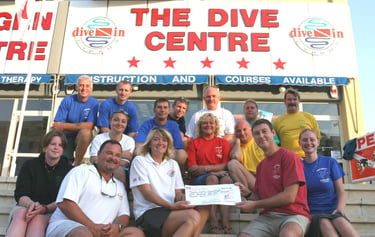
Following a PADI Instructor Development Course, newly qualified PADI Instructors took part in a sponsored beach clean and underwater up to help to protected endangered marine turtle in Cyprus.
Pictured: PADI Course Director Nom and Managing Director Clive Martin presenting WSBA Turtle Watch with cheque.
Is It Safe To Visit Palau Selingan?
We had a completely safe visit, as do many thousands of other visitors throughout the year.
However, there is a very strong caveat you need to consider, and you should always do your own research before travelling; there are many better resources than this page to get the most up-to-date information.
Turtle Islands National Park sits in the Sulu Sea, which is an area where terrorist groups have been known to operate. There is a large (but quite subtle) police and military presence, including on Selingan Island itself. A great deal of time and effort is spent by the Malaysian government in keeping the area safe but you should do your own research and weigh up any risks.
For reference, the islands off the coast of Sandakan are currently designated by the UK FCDO as ‘Advise against all but essential travel’ which may affect your travel insurance whilst in the area.
It goes without saying that safety is the number one priority, but we never once felt at risk or threatened during our stay.
Watching the Rangers releasing the baby turtles and seeing them flap their way to the ocean remains etched on our memories forever – a definite highlight of our Borneo itinerary!
The next morning, we transferred back to Sandakan and straight onto a 3D2N Kinabatangan River Safari.
Where to stay in Sandakan
The closest place to stay before or after your one night at Palau Selingan is Sabah's second city Sandakan.
We stayed at the conveniently located Hotel Sandakan which was close to shopping malls and the Sandakan Heritage Trails. The rooms are clean and comfortable and have everything you need for a quick sleepover.
If you’re on a budget, head for Borneo Sandakan Backpackers (around £14 for a double). For middle of the range, go for OYO 1030 Nak Hotel which has the best views from it’s very cool roof top terrace bar. This bar is open to non-residents so even if you’re staying elsewhere, it’s a good spot to have a cocktail (£5) and great pizza (£5 – the kids loved them!) and watch the sun go down.
After your Palau Selingan trip why not visit Sepilok Orangutan Rehabilitation Centre or take a Kinabatangan River Safari
Discover Our Other Guides
Phang Nga On A Backpacker Budget
Note: This post contains affiliate links. When you make a purchase using one of these affiliate links, we get paid a small commission at no extra cost to you.
SUBSCRIBE
Subscribe to our newsletter to always be the first to hear about recent Blogs and adventures.

